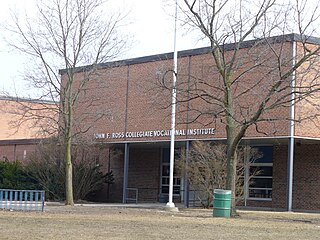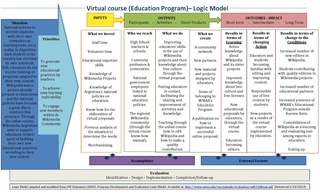Distance education, also called distance learning, is the education of students who may not always be physically present at a school. Traditionally, this usually involved correspondence courses wherein the student corresponded with the school via mail. Today, it involves online education. A distance learning program can be completely distance learning, or a combination of distance learning and traditional classroom instruction. Massive open online courses (MOOCs), offering large-scale interactive participation and open access through the World Wide Web or other network technologies, are recent educational modes in distance education. A number of other terms are used roughly synonymously with distance education.
In Australia, technical and further education or TAFE institutions provide a wide range of predominantly vocational courses, mostly qualifying courses under the National Training System/Australian Qualifications Framework/Australian Quality Training Framework. Fields covered include business, finance, hospitality, tourism, construction, engineering, visual arts, information technology and community work.

Vocational education is education that prepares people to work as a technician or to take up employment in a skilled craft or trade as a tradesperson or artisan. Vocational education is sometimes referred to as career and technical education.
Asynchronous learning is a general term used to describe forms of education, instruction, and learning that do not occur in the same place or at the same time. It uses resources that facilitate information sharing outside the constraints of time and place among a network of people. In many instances, well-constructed asynchronous learning is based on constructivist theory, a student-centered approach that emphasizes the importance of peer-to-peer interactions. This approach combines self-study with asynchronous interactions to promote learning, and it can be used to facilitate learning in traditional on-campus education, distance education, and continuing education. This combined network of learners and the electronic network in which they communicate are referred to as an asynchronous learning network.
A learning management system (LMS) is a software application for the administration, documentation, tracking, reporting, automation and delivery of educational courses, training programs, or learning and development programs. The learning management system concept emerged directly from e-Learning. Although the first LMS appeared in the higher education sector, the majority of the LMSs today focus on the corporate market. Learning Management Systems make up the largest segment of the learning system market. The first introduction of the LMS was in the late 1990s.
Educational technology is the combined use of computer hardware, software, and educational theory and practice to facilitate learning. Educational technology creates, uses, and manages technological processes and educational resources to help improve user academic performance.

Wyndham College is a government senior secondary school located at Nirimba Fields, New South Wales, Australia.
TAFE NSW is an Australian vocational education and training provider. Annually, the network trains over 500,000 students in campus, workplace, online, or distance education methods of education. It was established as an independent statutory body under the TAFE Commission Act 1990. The Minister for Regional Development, Skills and Small Business is responsible for TAFE NSW.
Technological literacy is the ability to use, manage, understand, and assess technology. Technological literacy is related to digital literacy in that when an individual is proficient in using computers and other digital devices to access the Internet, digital literacy gives them the ability to use the Internet to discover, review, evaluate, create, and use information via various digital platforms, such as web browsers, databases, online journals, magazines, newspapers, blogs, and social media sites.
TAFE NSW Hunter and Central Coast now forms a part of TAFE NSW, the largest training and education provider in Australia. All TAFE NSW Institutes were united as one 'TAFE NSW' in an ongoing process starting in 2017. TAFE NSW Hunter and Central Coast was also known as Hunter Institute of TAFE NSW.
Sydney is home to some of Australia's most prestigious universities, technical institutions and schools. Entry to tertiary education for most students is via the New South Wales secondary school system where students are ranked by the Australian Tertiary Admission Rank (ATAR).
Synchronous conferencing is the formal term used in computing, in particular in computer-mediated communication, collaboration and learning, to describe technologies informally known as online chat. It is sometimes extended to include audio/video conferencing or instant messaging systems that provide a text-based multi-user chat function. The word synchronous is used to qualify the conferencing as real-time, as distinct from a system such as e-mail, where messages are left and answered later.
TAFE Open Learning is a single point of contact for customers seeking distance education. TAFE Open Learning is located in South Brisbane, Queensland.
In the history of virtual learning environments, the 1990s was a time of growth, primarily due to the advent of the affordable computer and of the Internet.
Bradfield Senior College is a government-funded co-educational specialist senior secondary and vocational day school specialising in the creative industries, located on the Pacific Highway, St Leonards, New South Wales, in the lower north shore suburb of Sydney, New South Wales, Australia.

This National Conference is the biennial conference of the Australian Council for Computers in Education (ACCE). The conference opens to anyone who in interested in sharing their digital teaching experiences. The first conference took place in Melbourne, 1983. Between 1983-1996, the conference was held annually across Australia. After 1996, the conference became biennial. From 1994, a series of frameworks were launched in Australia to integrate Information and Communication Technology(ICT) into education. Western Australia's 2001 Competency framework for Teachers identified teachers as an important component in developing computer education. In 2010, Education Minister Julia Gillard, proposed an education agenda to provide Australia a better education system. Besides ACCE, there are many organizations and conferences supporting the development of computer education in Australia. Technology in education consists of two major approaches: Learning with technology and learning from technology. Technology in education learning and traditional classroom learning have different focuses and defining features. There are also four types of computer education:Bring your own device(BYOD), blended learning, online learning, and flipped learning.

Sydney Distance Education High School is a public distance education school in the inner-city suburb of Woolloomooloo in Sydney. The school is on the same site as the Plunkett Street Public School. It delivers individualised education programs to students in Years 7–12 whose special circumstances prevent them from attending regular schooling. It also provides curriculum delivery to students in Years 9–12 studying a single subject not available at their home school. It uses the decentralised model of distance education, where the form of teaching is determined based on a student's situation. The school caters to students living in the Greater Sydney region.

Digital pedagogy is the study and use of contemporary digital technologies in teaching and learning. Digital pedagogy may be applied to online, hybrid, and face-to-face learning environments. Digital pedagogy also has roots in the theory of constructivism.
TVET is education and training which provides knowledge and skills for employment. TVET uses formal, non-formal and informal learning. TVET is recognised to be a crucial vehicle for social equity, inclusion and sustainable development.
TVET in Sri Lanka refers to the development and implementation of Technical and Vocational Education and Training (TVET) in the Sri Lankan education system and labor market. In Sri Lanka, the formal TVET sector comprises about 635 public sector training centres and 718 private and NGO training centres. A large number of non-formal TVET providers also provide training in IT on a fee-for-service basis, and there is a widespread network of non-fee-levying institutions that are funded by various national and international charities. These providers educate people of all ages — from secondary school leavers to working adults, parents and others who have suspended their education for various reasons and need training or retraining.




